In today’s data-driven world, organizations increasingly rely on Business Intelligence (BI) and analytics platforms to unlock valuable insights, help make informed decisions, and drive business success. However, with the abundance of options available, selecting the right platform that aligns with your organization’s unique needs can be daunting.
Before delving into the evaluation process, it is crucial to highlight the need for a collaborative approach between IT and the business when choosing a solution. In a modern BI world, IT’s role is redefined as “empowering users across the organization to harness the power of data and analytics”. By involving both IT and business leaders in all aspects of the program, organizations can foster a culture of data-driven decision-making and ensure the successful implementation of a modern BI strategy.
This evaluation guide aims to support organizations as they navigate the process of evaluating and selecting a modern BI & analytics platform suitable for a broad, enterprise-wide deployment. Transitioning to a self-service-based, modern BI model requires a collaborative approach involving IT and the business. As such, this guide emphasizes the importance of engaging business users and analysts throughout the platform evaluation and selection journey.
The guide is structured to provide a comprehensive framework for evaluating and selecting the right platform. It covers various aspects of the modern analytics workflow, addressing the diverse needs of users across the organization.
The following topics are discussed in detail:
- Access and view: Assessing the platform’s capabilities for providing secure and easy access to data, allowing users to view and consume information effortlessly.
- Interact: Evaluating the platform’s interactive features that enable users to explore and manipulate data, fostering a deeper understanding of the underlying insights.
- Analyze and discover: Examining the platform’s analytical capabilities, including data exploration, advanced analytics, and data discovery tools that empower users to uncover valuable insights.
- Share: Assessing the platform’s collaboration and sharing functionalities, enabling users to collaborate seamlessly and share insights with colleagues and stakeholders.
- Promote and govern: Understanding the platform’s ability to promote and govern the use of analytics across the organization, ensuring consistency, scalability, and compliance.
- Data governance: Addressing the critical aspect of data governance, which encompasses data quality, security, privacy, and compliance to ensure the integrity and reliability of data.
- Analytics governance: Exploring the importance of analytics governance in establishing guidelines, processes, and controls for leveraging analytics effectively and responsibly.
We believe that by following this evaluation guide, you will be equipped with the knowledge and tools necessary to navigate the complex landscape of modern BI & analytics platforms and make a well-informed decision to drive your organization’s success.
